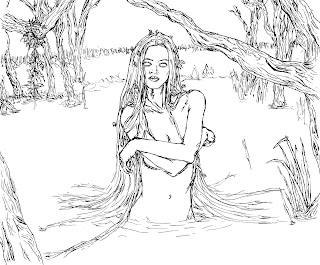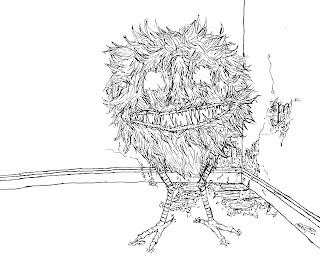Even though I don't consider my Style based work fashion illustration there are still obvious overlaps between the two. This means I have looked at quite a few fashion illustrators and artists over this project, though many only in passing.
Rene Gruau
Gruau has a very flat style in a lot of his work (at least the work of his that interests me) that I find visually striking and impactful at first but capture my attention for long. This may be fine for work in magazines and such to initially get the viewers attention but I feel like if the work was a little less simplistic but still maintained its flatness then it could be more visually interesting, maybe if some hints of texture were added (which he admittedly he does do every now and again).

I feel like this would be sort of similar to my sharpie work which is pretty flat but still interesting due to the sketchy nature of my work.
In general my drawings have a lot more going on than his which isn't necessarily a good thing but in this case I think it makes my work more visually captivating and interesting although the simplicity and graphic quality of his work may be more impactful initially.
Rene Bouche


Apparently Rene is the name to have if you want to be a fashion illustrator. Bouche's work is rather linear, with strong varied lines, kind of scribbly and used well with great effect to convey differences in material and texture. The way he uses differing lines and techniques to illustrate these differences is what interests me most about his work and is something I'm trying to achieve with greater clarity on my own work.
For example in his ink work he leaves the skin plain tonally while detailing the clothing with a wide spectrum of tones and washes. The hair is similar but less detailed than the clothing. Also while the hair and skin of the model is drawn rather definitively the clothing is a little more loose and gestural, while still having some intensity. In my ink work I use a similar disparity of marks and gestures to get a similar effect but unlike Bouche I don't put any emphasis on making the clothes stand out so draw every aspect of the model in the same sort of detail. This difference in Bouche's and I's work is due to how he is a fashion illustrator so his work is all about the clothing at the core; my work is more about the identity of the model as a whole so as much emphasis is put on the model themselves as the clothes they wear. While I do use different techniques and marks to show different materials and textures I also keep some similarities running through a piece to present each aspect as a whole unified being.
I'll write about other fashion illustrators in upcoming posts.
Image sources:
http://www.palaisgalliera.paris.fr/sites/galliera/files/styles/cloud_zoom/public/oeuvre/visuels_principaux/77439-26_1.jpg?itok=N55FiNtg
http://archdezart.com/wp-content/uploads/2011/12/gruau2.jpg
https://thewitcontinuum.files.wordpress.com/2013/05/33524-rene-bouche-1955-p2-christian-dior-jacques-heim-evening-gown-hprints-com.jpg
https://s-media-cache-ak0.pinimg.com/736x/07/05/65/070565d965d62a623cb6599fe32d81c4.jpg

























